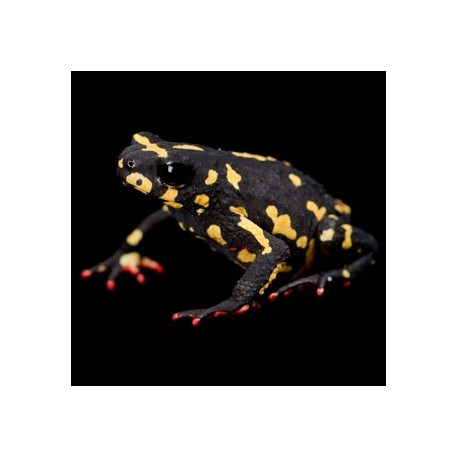No Products
 View larger
View larger Bumble Bee Walking Toads
Bumble Bee Walking Toads (Melanophryniscus stelzneri)
This product is currently out of stock
More Info
Bumble Bee Walking Toads (Melanophryniscus stelzneri) are an easy to care for species from Northern Argentina, Paraguay, Southern Brazil, and Uruguay. Most, but not all, males are approximately 25 mm (1 inch) and females average about 30-35 mm (1.2-1.4 inches). In some cases, large females can reach 40 mm (1.6 inches).
Temperature
These toads tolerate a broad temperature range. The ideal range seems to be 70-80 ° F (21-27 °C). Occasional temperatures into the low 90s °F (low 30s °C), or down to about the mid-forties Fahrenheit (7 °C) have not been harmful, though the toads are not very active at these times. Humidity levels should be maintained at about 60-80% the majority of the time, as they are less active and hide when it gets much higher or lower.
Housing & Setup
When housing these toads, a good rule of thumb is to allow a minimum of 2.5 gallons (10 liters) of tank volume per toad, with no tank smaller than 5 gallons (20 liters) and no more than 10 toads per tank, no matter the size. These toads don't really need a great deal of space.
Pea gravel, topsoil leaves, and ground coconut husk can be used as substrate, basically anything that doesn’t make the humidity too high with the amount of ventilation you use. A shallow, small to medium sized water dish should be provided. Live or artificial plants, particularly Pothos (Devil's Ivy, Epipremnum aureum), are recommended, as they improve the terrarium's looks, and the toads seem to enjoy climbing up the plants. The toads are not very skilled climbers and often fall, but no harm results. Keep in mind when setting up the habitat that, although they are very adaptable, they are reported to be from a savanna-type area where they are said to have grasses and small shrubs rather than bromeliads and similar plants.
Feeding
These toads tend to be very enthusiastic eaters. Feeding adults is no problem as long as plenty of small food items are maintained. Keep in mind that they eat a lot of food for their size - more than a similar sized dart frog would eat. Pinhead crickets, fruit flies, termites, small harmless ant species, small roach nymphs, small silkworms, waxworms, and almost any other harmless insect of a similar size are acceptable as food items.

